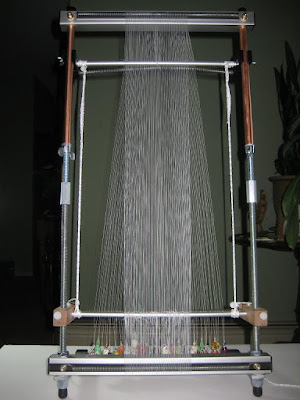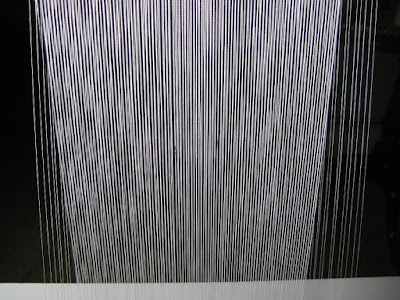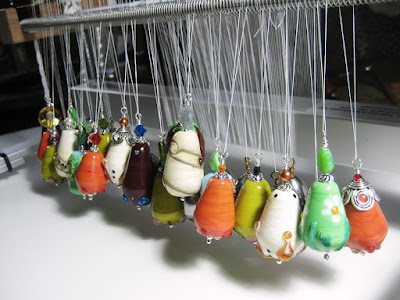I am thoroughly in love with my Mirrix! I have been wanting to create a very substantial split loomed necklace, for sometime. The 16inch Mirrix is perfect, for what I plan to create. I will share my progress here on the blog, but stay with me because some of my ideas will be new techniques. If they don't work out, I won't photo til they do!
My Mirrix is strung with 93 warps. I included the extensions, longer foot pediments and warp weights.

My design is 92 beads wide. Therefore, your loom is strung one warp more then the number of beads in a row, 93 warps. The center 17 warps are going to handle 16 beads of stable looming. I will explain further as I go along, then it will all make sense.

Notice the black marks on the two warps, in the picture above. This is the outside of my 16 beads. For now, I am only going to loom the widest portion of my piece, a split loomed necklace.
My design idea includes some 'cut work' into my looming and 'wavy edging'. Therefore, I need to include 'warp weights'. The warps are secure at the base of this loom, but are brought over top and a 'warp weight' is attached to every two warps. The Mirrix is so great, because I was able to 'increase the height' to handle my pattern, and the warp weights are secured in between the additional springs that come with the Mirrix.
These warp weights were custom made, especially for this method of looming.

Many designs were discussed, but this is the best design to handle some very creative ways to loom. These warp weights, along with a tutorial to create 'cut work' and 'wavy edges', can be ordered from Venessa Hearn at
Bead Up A StormI hope you will stay with us for me to share how the Mirrix, and these warp weights, can create some of the most intricate looming! For now, I'll be adding my longest row of beads, to start!









 After looking at the yarns again and seeing others that appealed, I have decided that I will make an unplanned textured tapestry piece on the
After looking at the yarns again and seeing others that appealed, I have decided that I will make an unplanned textured tapestry piece on the 







 Color wheels are ubiquitous. Most of us have used them. Many have studied color theory extensively. I have to admit that I have not had that opportunity and often I regret that. However, as a friend of mine said, every time she thinks about color too much, she doesn’t like what she’s done. I have those same feelings and much prefer to go by my gut, or more politely, instinct. Or maybe just call it going by the seat of my pants. That is a saying, right? That’s not to say that I don’t use color tools. I do. I’ve mentioned my favorite computer program before,
Color wheels are ubiquitous. Most of us have used them. Many have studied color theory extensively. I have to admit that I have not had that opportunity and often I regret that. However, as a friend of mine said, every time she thinks about color too much, she doesn’t like what she’s done. I have those same feelings and much prefer to go by my gut, or more politely, instinct. Or maybe just call it going by the seat of my pants. That is a saying, right? That’s not to say that I don’t use color tools. I do. I’ve mentioned my favorite computer program before, 


 There’s this one by
There’s this one by 














 The text that I am attempting to weave is similar to the above, but with thicker lines, and believe me, it is definitely a work in progress! The T and the E are complete. I am weaving them with the T lying on its side, but am wondering if the direction would be better if I had started from regular “reading” direction. I thought I’d need fewer butterflies with the sideways weaving, but it didn’t work that way. Any experience weavers want to comment? In the picture below you can see the outline of the next letters to be woven drawn on the warp with a Sharpee. Please keep in mind, this weaving is purely experimental, and I am not endorsing the design or the quality of the weaving! It’s a little embarrassing to even show this stuff!
The text that I am attempting to weave is similar to the above, but with thicker lines, and believe me, it is definitely a work in progress! The T and the E are complete. I am weaving them with the T lying on its side, but am wondering if the direction would be better if I had started from regular “reading” direction. I thought I’d need fewer butterflies with the sideways weaving, but it didn’t work that way. Any experience weavers want to comment? In the picture below you can see the outline of the next letters to be woven drawn on the warp with a Sharpee. Please keep in mind, this weaving is purely experimental, and I am not endorsing the design or the quality of the weaving! It’s a little embarrassing to even show this stuff!



![clip_image001[4] clip_image001[4]](https://blogger.googleusercontent.com/img/b/R29vZ2xl/AVvXsEgoJ15LWFJZJpM1aGv0ihtSyoa8ccLtCZJ8qBUSNsOjmhiXgMXolyxmwHJRQEtTxcZrWCvW8zDQHDPfTBtDkLQ7s8Bjy1hWbxPgM1nU0tfHA57mIgkJpOoJRGhpEl0g9cyQuI_APXsLsEWp/?imgmax=800)
![clip_image001[6] clip_image001[6]](https://blogger.googleusercontent.com/img/b/R29vZ2xl/AVvXsEiF45UoHAAXUB-Hnrwb5ddWpe2JZXjJ-hS1SrumSXV06kvp3tvV0qTzXzkKinBpXufaFlDAaT7wLl3CPcgnkgbEi-OPhKww9iqSlWUlUkrvYS4AY1NhTQDcr_IvbMLgGft6AG3yAmm2N8Ha/?imgmax=800)




